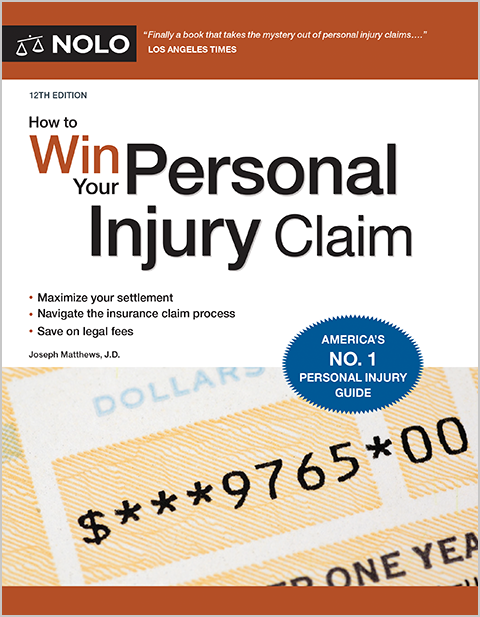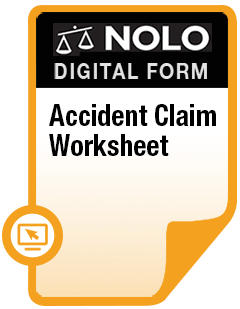How a property owner's insurance coverage will affect an insurance claim or lawsuit over a slip and fall.
You've been invited to a party at a neighbor's house on a dark, frozen winter night. While making your way up the walkway to the front door, you suddenly lose your footing and take a hard fall onto your low back. Two days later, your family doctor tells you that you've injured your lumbar spine. By the time you've reached what's known as "maximum medical improvement" (MMI), you're out of pocket $4,500 for medical bills, therapy visits, and medications.
Is this accident covered by your neighbor's homeowners' insurance? If your neighbor is insured, the answer is yes, it should be covered. But in order to receive compensation (called "damages") from the insurance company, you'll need to know how to make a slip-and-fall claim. We explain how you do that.
Is There Homeowners' Insurance?
When you're injured on another homeowner's property, the first thing you want to know is whether they have homeowners' insurance. Most do. If the home is mortgaged then it's almost certainly insured, because mortgage companies require it. But if the property is mortgage-free, it's possible the homeowner doesn't have insurance.
Unfortunately, there's no such thing as a "homeowners' insurance registry" that you can check. The only way to find out about coverage is to ask, or to make a claim for your injuries and see if they turn it over to an insurer.
If the homeowner doesn't have insurance, you can still make a claim against them for your injuries. The same is true if the homeowner has insurance, but the policy limit is too low to cover all your personal injury damages. In that event, you'll bring a claim against the insurer for the policy limit, and go after the homeowner for the excess.
Before you bring a claim against an uninsured or underinsured homeowner, make sure you'll be able to collect any amount you win. There's little point in chasing someone who's judgment proof, meaning without insurance or assets to pay you.
What Kinds of Insurance Coverage Do They Have?
A typical homeowners' policy has two kinds of insurance that might apply to a slip and fall claim: Medical payments coverage (sometimes called "med pay") and liability coverage.
Medical Payments Coverage (Med Pay)
As the name suggests, medical payments coverage pays the medical bills of a person who gets hurt on another's property. Most insurers include med pay as part of a homeowner's full-coverage policy, but the amount is typically quite small—$2,000 to $5,000 per individual. Homeowners can purchase additional coverage, but most don't.
The good news is that med pay is a kind of "no fault" insurance, meaning that you don't have to prove the homeowner was negligent to collect. As long as you can prove you were hurt on the property, med pay will reimburse your medical bills up to the coverage limit.
Collecting medical payments coverage is simple. Just send your medical bills to the insurance adjuster assigned to your claim, and the insurer will reimburse you—again, up to the limit of coverage.
Liability Coverage
What if your medical bills are more than the homeowner's med pay limit, or you want to recover other damages like lost wages or pain and suffering? In that case, you'll need to bring a claim against the homeowner's liability coverage. But collecting this insurance won't be as simple as getting med pay. Here's why.
A homeowner's liability insurance will pay for your slip and fall damages only if the homeowner is liable for your slip and fall. As a general rule, a homeowner will be liable for your injuries only if:
Contrary to popular fiction, the fact that you fall on someone's property doesn't automatically mean the property owner was negligent. You have to prove that you fell because of some unsafe condition on the property, that the owner knew or should have known of the condition, and they failed to take appropriate steps to fix it or warn others about it.
Return to our hypothetical facts above. If you slipped because there was a patch of ice on your neighbor's walkway that was difficult or impossible to see in the dark, your neighbor might have been negligent in failing to remove the ice or failing to warn you of the danger.
Be sure to check your state law for different or additional requirements and defenses to liability. For instance, in many states, if the homeowner can prove that the unsafe condition was "open and obvious" to anyone paying attention, your negligence claim might fail.
If you're unsure about the law, contact an attorney who handles premises liability cases.
What Are the Steps to Bring a Slip and Fall Claim?
The steps we describe below are specific to cases where the homeowner has an insurance policy and is willing to give you the insurer's name. But the homeowner might be reluctant to give you this information. Why?
Some insurers will cancel a homeowners' policy, or significantly raise premiums, if even one claim is made. For this reason, some homeowners refuse to report claims to their insurer and will try to handle claims themselves.
Document Your Fall and What Caused It
If you're hurt in a slip and fall, your first priority should be getting the medical care you need. As soon as you're able, do what you can to document what happened and how it happened. Here are some suggestions.
- Talk to others who were there when you fell to see if they encountered the same unsafe condition.
- If you can, get photos of the location under the same or similar circumstances—lighting, weather, accumulations of snow or ice, or whatever caused to you slip, trip, and fall.
- Make notes as soon after your fall as possible, recording what you saw, how the fall happened, and what others said or did at and after the time you were hurt.
- Keep detailed notes about your injuries, any limitations you've experienced, and the medical care you've received.
Report Your Claim as Soon as Possible
Report your claim to the homeowners' insurer as soon as possible. Make this report in writing, via certified mail with a return receipt requested to prove delivery. If the insurer has an online claim reporting page, you can report it there, too.
Keep your report short and factual. Identify the homeowner, the address, and the date you were injured. Provide a brief description of your injuries. Don't offer any more detail than necessary, and don't exaggerate your injuries. If you've finished treating with your doctor, say that you'll follow your report with a settlement demand.
If you're still receiving treatment, tell the insurer that you'll follow up once your treating doctor says you've reached MMI. Explain that you intend to seek recovery under "all available coverages." Finally, make it clear that at this point, you're not willing to give any kind of additional written or recorded statement.
How Do I Deal With Insurance Adjusters?
Once you report your claim to the insurer, the company will assign an insurance adjuster to the case. Their official title is probably something like "Claims Representative" or "Claims Manager." Regardless of the title, or what they might tell you about their role, an adjuster isn't your friend. Their job is to pay you as little for your claim as they can, and most often, to take as long as possible before writing you a check.
You control the claim. The adjuster wants to take control of the case and dictate the terms on which you move forward. You don't want that to happen. Remember that you retain control over your claim, at least until the point when you file a lawsuit (if the case doesn't settle). Be courteous and professional, but not overly friendly. Don't engage in small talk or banter, and don't volunteer information about your case, your injuries, or your treatment.
Recorded statements are a bad idea. The adjuster will ask you to give a recorded statement about what happened. As a rule, this is a bad idea. Keep in mind that anything you say can be used against you later in your case. The adjuster wants you to talk, because it gives them ammunition. Nothing good can come of you giving a statement.
Be prepared: The adjuster won't take "no" for an answer, and will try all sorts of tactics to get you to give in. For example, they might say "Our company won't settle without a statement from you." Or "I need you to tell your story so I can convince my supervisor to settle with you." Don't fall for it.
Here's what the adjuster knows, but almost certainly won't tell you: If the case doesn't settle and you sue, the insurer is guaranteed a chance to get your recorded statement—called a "deposition"—as part of the case.
Your medical records and bills. The adjuster will want to get your medical records and bills as your medical treatment progresses, and will also want documentation supporting any lost earnings you might claim. This is a fair request. Tell them you'll supply these records when you send a settlement demand.
The adjuster will want you to sign releases allowing them to get this information. At this point, don't sign any records releases. This answer will make the adjuster even more unhappy than your refusal to give a statement. Be ready for a laundry list of reasons why giving them releases is a good idea. As with the request for a recorded statement, the adjuster wants to take control of your case. Don't let that happen.
Prepare a Settlement Demand Letter
Once you've reached MMI (or if you're not at MMI but you're concerned about the statute of limitations on your claim), you'll need to prepare a settlement demand letter. As the name suggests, this is a letter that describes your fall, how you were injured, and your damages.
You'll want to attach copies of your medical records and bills, letters from employers documenting lost wages, and any other proof of your injuries and damages. In the letter you should demand payment for your "economic" damages (medical bills, lost wages, and other items that are easy to quantify in dollars) and your "noneconomic" damages (things like pain and suffering that can be trickier to reduce to dollars).
Ideally, your demand letter will start a negotiation between you and the insurer. Your initial demand should be for something more than the lowest figure you're willing to accept in settlement, so you can negotiate to reach a resolution.
If the case doesn't settle, you'll need to decide whether you want to file a lawsuit. Be wary of the statute of limitations on your claim. If you fail to file in court before the statute runs out, your claim is probably lost forever.
Get Help With Your Slip and Fall Claim
If the case gets to the point that you're thinking about a lawsuit, give serious thought to hiring an attorney who's experienced in handling slip and fall cases. Once you file suit, you're playing by the court's rules. The insurance company and its lawyers know these rules well, and they also know how to use them against you.
Go into that battle without legal counsel on your side and, quite simply, you're in over your head. Here's how to find a lawyer who's right for you and your case.


